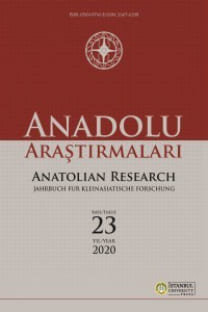THE ROLE OF THE ENSLAVED POPULATIONS IN THE URARTIAN SETTLEMENT POLICY
Öz The Kingdom of Urartu faced many challenges apart from overcoming geographical difficulties in order to implement its settlement policy in its heartland – the Van Lake Basin. Founding new cities, creating lands suitable for agriculture and securing the necessary population in order to supply its military strength were just some of them. Settling nomadic and seminomadic tribes and securing the manpower that were to build new cities and establish new farmlands also meant economic success for the kingdom that was to follow. The continuity of this success was only possible with a standardized settlement policy. Obtaining the population that were to be settled and their addition into the kingdom meant establishment of new cities and new campaigns. A policy of slave procurement, whose rules were already established by Assyria, was an important factor for obtaining the population Urartu needed. Although it is not known how this enslaved population was treated in the general Urartian population, it is certain that they were part of the production, fought for the kingdom and have taken part in foundation of new cities.
Anahtar Kelimeler:
Assyria, Urartu, Settlement Policy, Enslaved Population
___
- CTU I: M. Salvini, Corpus dei testi urartei, vol. I: Le iscrizioni su pietra e roccia, I Testi, Documenta Asiana VIII, Roma: CNR Istituto di Studi sulle Civiltá dell’Egeo e del Vicino Oriente, 2008.
- UKN I: G. A. Melikishvili, Urartskie Klinoobraznye Nadpisi I, Izdatel’stvo Akademii Nauk SSSR, Moskva, 1960.
- Çilingiroğlu, A. 1983 “Urartu’da Toplu Nüfus Aktarımları”, Anadolu Araştırmaları IX, İstanbul: 311-323.
- Kleiss, W. 1978 “Bastam and the East of Urartu”, G. Leni- L. B. Zekiyan (eds), Atti del Primo Simposio Intemazionale di Arte Armena Pergamo, 2S Ugiugno 1975, Venice, San Lazzaro: 395-402.
- Konakçı, E. 2009 “Urartu Krallığı’nın Siyasi ve Ekonomik Yapılanmasında Toplu Nüfus Aktarımları”, H. Sağlamtimur- E. Abay- Z. Derin- A. Ü. Erdem- A. Batmaz- F.Dedeoğlu- M. Erdalkıran- M. B. Baştürk- E. Konakçı (eds), Altan Çilingiroğlu’na Armağan, Yukarı Denizin Kıyısında Urartu Krallığı’na Adanmış Bir Hayat/ Studies in Honour of Altan Çilingiroğlu. A Life Dedicated to Urartu on the Shores of the Upper Sea, İstanbul: 367-383.
- Konyar, E. 2011 “Excavations at the Mound of Van Fortress/Tuspa”, Colloquium Anatolicum X: 147-166.
- Konyar, E.- Avcı, C. 2014 “Van-Tušpa Excavations 2013”, Colloquium Anatolicum, XIII:205-228.
- Konyar, E- Avcı, C.- Genç, B.- Akgün, R.G. – Tan, A. 2013 “Excavations at the Van Fortress, the Mound and the Old City of Van in 2012”, Colloquium Anatolicum, XII:193-210.
- Konyar, E- Avcı, C.- Yiğitpaşa, D- Tan, A.- Tümer, H. 2016 “Eski Van Şehri, Kalesi ve Höyüğü 2014 Yılı Kazı Çalışmaları”, 37. Kazı Sonuçları Toplantısı, 2. Cilt, Ankara:573-590.
- Mumford, L. 2007 Tarih Boyunca Kent, Kökenleri, Geçirdiği Dönüşümler ve Geleceği, G. Koca- T. Tosun (trans.), İstanbul.
- Oded, B. 1979 Mass Deportations and Deportees in the Neo-Assyrian Empire, Wiesbaden: Dr. Ludwig Reichert Verlag.
- Page, S. 1968 “A Stela of Adad-nirari III and Nergal-Ereš from Tell Al Rimah”, Iraq, Volume 30, No.2, London:139-153.
- Payne, M. R. 2006 Urartu Çiviyazılı Belgeler Kataloğu, İstanbul.
- Parpola, S. 1972 “A Letter from Šamaš-šumu-ukīn to Esarhaddon”, Iraq, Volume 34, No. 1, London:21-34.
- Piotrovsky, B. B. 1969 The Ancient Civilization of Urartu, J. Hogarth (trans.), Cenevre: Nagel.
- Reade, J. 1999 British Museum Assyrian Sculpture, Massachusetts.
- Salvini, M. 2001 “The Inscriptions of Ayanis-Cuneiform and Hieroglyphic”, A. Çilingiroğlu - M. Salvini (eds), Ayanis I, Ten Years Excavationsat Rusahinili Eidurikai 1989-1998, Roma: 253-270.
- Sevin, V. 1979 “Urartu Krallığı’nın Tarihsel ve Kültürel Gelişimi”, İstanbul Üniversitesi Sosyal Bilimler Enstitüsü Eskiçağ Tarihi Ana Bilim Dalı Doçentlik Tezi, İstanbul.
- Zimansky, P.E. 1995 “The Urartian Frontier as an Archaelogical Problem”, M. Liverani (ed.), NeoAssyrian Geography- Quaderni di Geografia Storica, volume 5, Rome: Universita di Rome:171-180.
- Zimansky, P.E- E.C. Stone 2004 “Urartian City Planning at Ayanis.” A. Sagona (ed.), In A View from the Highlands: Archaeological Studies in Honour of Charles Burney, Ancient Near Eastern Studies Supplement 12. Louvain: 233-243.
- ISSN: 0569-9746
- Yayın Aralığı: Yılda 2 Sayı
- Başlangıç: 1955
- Yayıncı: İstanbul Üniversitesi Edebiyat Fakültesi
Sayıdaki Diğer Makaleler
THE EARLY NEO-ASSYRIAN PROVINCIAL ARMY OF GŪZĀNA
BATHONEA. A SITE THAT NEVER EXISTED
URARTU KRALLIĞI’NDA HAYVANCILIĞIN SOSYO EKONOMİK ACIDAN ÖNEMİ
NEW OBSERVATIONS OF THE DOGUBAYAZIT ROCK-CUT TOMB
RETHINKING: ON THE URARTIAN IVORY ARTEFACTS
THE ROLE OF THE ENSLAVED POPULATIONS IN THE URARTIAN SETTLEMENT POLICY
